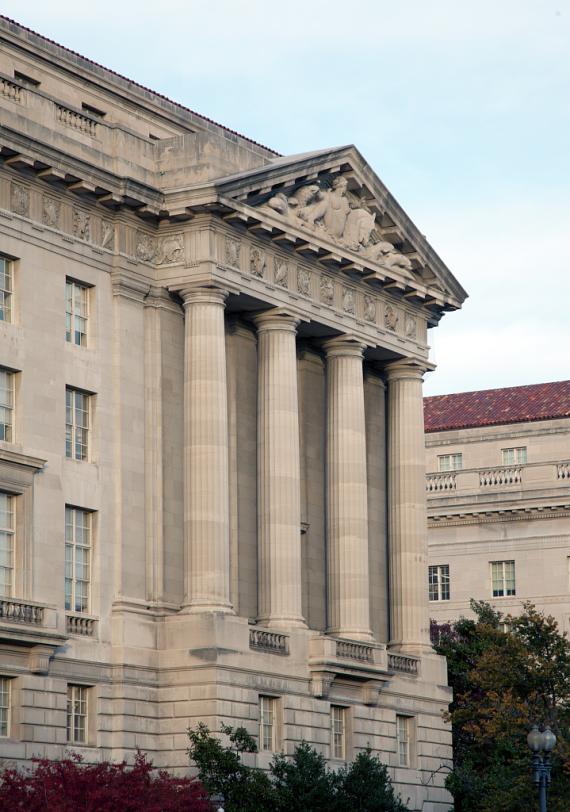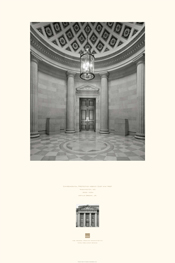Location: 1200 Pennsylvania Avenue NW, Washington, DC 20004
History
In the early twentieth century, the area of Washington, D.C., now known as the Federal Triangle was one of the city’s most blighted neighborhoods. In an attempt to improve the city, the federally funded Senate Park Commission developed an urban redevelopment plan that incorporated the ideals of the City Beautiful movement. The 1901 McMillan Plan, as it came to be known, proposed that the triangular area between Pennsylvania Avenue, the National Mall, and the Ellipse be developed as an enclave of monumental, classically inspired federal buildings.
Implementation of the seventy-acre Federal Triangle project went unrealized until the passage of the Public Buildings Act of 1926, which authorized $50 million for the construction of new buildings in the District of Columbia. At the urging of the American Institute of Architects, the U.S. Treasury Department turned over principal design responsibilities to a Board of Architectural Consultants, comprised of private architects, who formulated an overall scheme for the Triangle and then divided design tasks for the individual buildings.
Arthur Brown, Jr., (1874-1959) received the responsibility to design a three-part building group facing Constitution Avenue that would house the Interstate Commerce Commission, Departmental Auditorium, and Department of Labor. Brown, a San Francisco-based architect who trained at the Ecole des Beaux Arts, designed the buildings between 1928 and 1931, and construction was completed in 1934. The Interstate Commerce Commission, which regulated carriers engaged in transportation between states, occupied the east building of the complex until the agency was abolished in 1995. The Department of Labor vacated the west building in 1979, after which it housed the U.S. Custom Service. In 2002, following a major modernization, the Environmental Protection Agency (EPA) took occupancy and the structures became known as EPA East, the Andrew W. Mellon Auditorium, and EPA West. The complex was listed in the National Register of Historic Places as part of the Pennsylvania Avenue National Historic Site in 1966.
Architecture
The three-part building ensemble consisting of EPA East, the Andrew W. Mellon Auditorium, and EPA West faces Constitution Avenue and is situated between Twelfth and Fourteenth streets in the Federal Triangle of Washington, District of Columbia. Conceived as a whole composition, the buildings in the Federal Triangle possess similar materials, tiled roofs, and an orchestrated rhythm of pavilions and colonnades. The Mellon Auditorium, with its Roman Doric temple front, is the central focus of the grouping and linked to the symmetrical east and west wings by narrow connectors with arched open portals. The complex was intended to be part of a U-shaped group, but while EPA East connects perpendicularly with the Ariel Rios Federal Building, the north arm was never executed.
Intended to be twin buildings, EPA East and West have seven stories plus basement and attic. Faced in Indiana limestone with a steel frame, the buildings have a rectangular plan pierced by central light courts. Each facade is divided horizontally into three horizontal bands. The rusticated base includes the first and second stories, with projecting end pavilions, rectangular windows topped by keystones carved with figural heads, and a central arched entrance. The third through sixth stories comprise the smooth-faced middle section. On the third floor, alternating windows have a balcony and balustraded balconet. The pavilions each have fluted Doric columns, supporting an entablature with a frieze that has alternating triglyphs and metopes carved in twenty-six varying designs. Pediments have elaborately carved sculpture groups representing the activities of the agencies for which the buildings were constructed. The top section includes the set-back seventh floor and is topped by a roof clad in variegated terracotta tile.
The interiors are richly finished with marble floors and limestone walls, aluminum and brass ornamental metal work, wood paneling, vaulted ceilings, murals, and bas relief. Lobbies have coffered plaster ceilings with decorative paint treatment. Requirements of the Interstate Commerce Commission, the first agency to occupy EPA East, influenced the interior design. Bisecting the central first floor corridor, the two-story rotunda has a marble floor with a star design at the center. Eight engaged Doric columns ring the room, supporting a heavy entablature from which ascends a coffered plaster dome lit by an oculus. Two large, nearly identical public hearing rooms flank the rotunda to the east and west, and have oak walls with window and door openings framed by pilasters. The commissioners’ bench is of paneled wainscot, and behind it is a canvas mural with a United States map highlighted with trade locations and routes. Other significant spaces include the commissioner’s suites with private offices and reception rooms, and the commissioners’ conference room on the fourth floor.
Due to the less public aspect of the Labor Department and a decreased need for meeting spaces, the interior of EPA West is simpler than that of its counterpart. However, the executive office suite on the third floor has oak and birch paneled walls and oak parquetry floors with grey marble borders. Designed for the secretary of labor, the ceremonial office has a verde antique marble chimneypiece and high ceiling finished with oak beams.
Significant Events
- 1901: McMillan Plan proposes development of future Federal Triangle area
- 1926: Public Buildings Act of 1926 authorizes funding
- 1932-1934: Three building complex constructed
- 1966: Pennsylvania Avenue Historic Site listed in the National Register
- 1979: Department of Labor vacates and U.S. Customs Service occupies building
- 1995: Interstate Commerce Commission dissolved
- 2002: EPA occupies building
Facts
- Architect: Arthur Brown, Jr.
- Architectural Style: Classical Revival
- Construction Dates: 1932-1934
- Landmark Status: Listed in the National Register of Historic Places as part of the Pennsylvania Avenue National Historic Site
- Primary Material: Indiana Limestone
- Prominent Feature: Classical facades with Beaux Arts sculpture
Poster Downloads
Download the Poster [PDF - 608 KB]

 U.S. General Services Administration
U.S. General Services Administration

